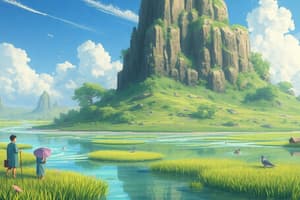Podcast
Questions and Answers
Quelle est l'une des composantes d'un environnement?
Quelle est l'une des composantes d'un environnement?
- L'eau potable (correct)
- L'agriculture
- La démographie humaine
- Le réchauffement climatique
Qu'est-ce qui est considéré comme un indicateur du développement durable?
Qu'est-ce qui est considéré comme un indicateur du développement durable?
- Accessibilité aux soins
- Indice de développement humain (correct)
- Taux de scolarisation garçons/filles
- PIB : produit intérieur brut
Quel concept est associé à la préservation des ressources naturelles et de la biodiversité?
Quel concept est associé à la préservation des ressources naturelles et de la biodiversité?
- Développement durable (correct)
- Réchauffement climatique
- Education environnementale
- Epuisement des ressources naturelles
Quel indice mesure l'impact sur l'environnement?
Quel indice mesure l'impact sur l'environnement?
Quelle dimension est associée à la crise environnementale?
Quelle dimension est associée à la crise environnementale?
Quelle est la définition de l'environnement selon le texte?
Quelle est la définition de l'environnement selon le texte?
Qu'appartient aux êtres vivants selon le texte?
Qu'appartient aux êtres vivants selon le texte?
Quelle est la signification du développement durable selon le texte?
Quelle est la signification du développement durable selon le texte?
Quelle est l'action du développement économique selon le texte?
Quelle est l'action du développement économique selon le texte?
Quelles sont les principales dimensions de la crise environnementale selon le texte?
Quelles sont les principales dimensions de la crise environnementale selon le texte?
Flashcards
Environment
Environment
All living and non-living elements surrounding an individual or species, providing resources for survival.
Sustainable Development
Sustainable Development
Development that meets current needs without harming future generations’ ability to meet their own.
Development
Development
Process of growth, progress, expansion, and complexity over time.
Environmental Crisis
Environmental Crisis
Signup and view all the flashcards
Population Growth
Population Growth
Signup and view all the flashcards
Climate Change
Climate Change
Signup and view all the flashcards
Non-renewable Resources
Non-renewable Resources
Signup and view all the flashcards
Natural Resource Depletion
Natural Resource Depletion
Signup and view all the flashcards
Biodiversity Loss
Biodiversity Loss
Signup and view all the flashcards
Sustainable Development Goals
Sustainable Development Goals
Signup and view all the flashcards
Study Notes
-
Definitions: 1.1. Environment: The environment is defined as the sum of all living and non-living elements that surround an individual or species and provide resources for their survival. It includes natural resources such as air, water, soil, flora, fauna, and the interactions between them, as well as human-made structures and productions. In legal terms, the Algerian law n° 03-10 of July 2003 defines the environment as "the ensemble of elements (biotic or abiotic) that surround an individual or a population and that contribute directly or indirectly to their existence and development." 1.2. Components of an environment: Our environment consists of living beings and non-living matter. a. Living beings: Living beings belong to two main categories: fauna (animals) and flora (plants). b. Non-living matter: Non-living matter includes minerals (water, rocks, air), the remains of living beings ( feathers, bones, wood, fallen leaves, dead animals), and human creations (fields, houses, bridges, etc.). 1.3. Sustainable Development: Sustainable development is defined as "development that meets the needs of the present without compromising the ability of future generations to meet their own needs" (Report Bruntland for the World Commission on Environment and Development, UN, 1987).
-
Significance of Development: Development refers to the process of growing, progressing, expanding, and complexifying over time. Economic development signifies positive economic changes in a geographical area or population, but it also entails negative environmental impacts.
-
Environmental Crisis: 3.1. Population Growth: The global population increases by approximately 89 million people each year, reaching 7.63 billion in January 2018. With a daily population increase of 244,000, or 2.7 per second, the rapid population growth poses significant challenges to human well-being. 3.2. Climate Change: The global climate is warming, with rising temperatures, increased precipitation, and melting glaciers. This poses threats to ecosystems, human health, and economies. 3.3. Non-Renewable Energy Sources: Fossil fuels, such as coal, oil, and natural gas, are finite resources increasingly exploited for energy production. Their burning contributes to greenhouse gas emissions, air pollution, and climate change. 3.4. Depletion of Natural Resources: The overexploitation of natural resources, such as water, minerals, and forests, increases their scarcity and threatens ecosystems and human well-being. 3.5. Water Scarcity: Access to clean water is becoming a scarce resource, with increasing demand for agricultural, industrial, and domestic uses. 3.6. Biodiversity Loss: The rapid extinction of species is a major concern, threatening ecosystems and the services they provide. 3.7. Agriculture: Agriculture, which feeds the growing global population, is a significant contributor to greenhouse gas emissions and resource depletion. It also poses threats to soil health, water resources, and biodiversity.
-
Sustainable Development Goals, Principles, and Indicators: 4.1. Objectives: The sustainable development goals address various environmental, social, and economic challenges, including poverty, hunger, health, education, gender equality, clean water and sanitation, affordable and clean energy, industrial growth, and reduced inequalities. 4.2. Principles: The principles of sustainable development include equity, efficiency, and sustainability. They originated from the 1992 United Nations Conference on Environment and Development (UNCED) in Rio de Janeiro. 4.3. Indicators: Some sustainable development indicators include ecological footprint, bio-capacity, environmental impact, human development index, and Gross Domestic Product (GDP). These indicators provide insights into the state of the environment, human well-being, and economic development. 4.4. Education and Awareness: Education and awareness campaigns are essential for promoting sustainable development practices among individuals and communities. 4.5. Communication: Effective communication and collaboration across sectors, industries, and governments are crucial to achieving sustainable development goals.
Studying That Suits You
Use AI to generate personalized quizzes and flashcards to suit your learning preferences.
Description
Ce quiz porte sur les définitions de l'environnement, les composantes d'un environnement, le développement durable et la signification du développement. Il aborde également les principales dimensions de la crise environnementale, le concept du développement durable et ses raisons, ainsi que le concept du développement durable dans son ensemble.




